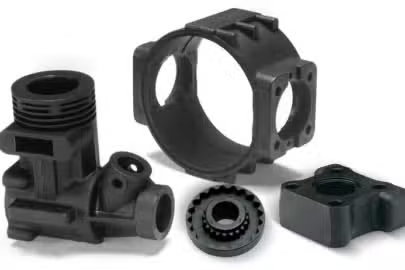Metals, which are used in a variety of sectors, have qualities such as strength, ductility, and conductivity. Metal mechanical characteristics are critical in creating long-lasting components for a variety of loads and situations. Surprisingly, these qualities may be visually deciphered using a metal strength diagram, a tool crucial in understanding and effectively utilizing these materials in areas like CNC Machining Services and Sheet Metal Services.
Metal strength diagrams illustrate the combination of metal’s tensile strength, yield strength, elongation, and area reduction. The figure shows metallic behavior of the eutectoid carbon steel, under different loading conditions which helps in selecting appropriate materials for applications such as metal bending and laser cutting. Such compact representation is important when making judgments on the materials used because the engineering systems should be safe and efficient.

Why are these metal strength diagrams important? How does it influence engineering and production processes? This article simplifies the complicated universe of metal strength so that readers appreciate the basics of material choice in the industrial sector.
Understanding Metal Strength Diagram
The metal strength provides the component durability and reliance on the particular case of metals when their strengthening is principal. These include metals that are strong like steel in processes such as CNC milling and rapid prototyping. Determining the characteristics that makes it appropriate and unsuitable depending on its suitability or otherwise for multiple applications including die casting. The strength of a metal depends on the composition, microstructure, as well as processing methodologies. The increase in strength results from crystallinity for metal has a higher level of crystallinity and tight packing of atoms. Besides that, it is possible for other metals which will be used in combination with the heat treatment process or varying alloys to have a more significant advantage.
A metal strength diagram provides a useful method for illustrating how some properties like hardness, density, tensile strength or yield strength are correlated. Both these kinds of diagrams explain how a particular material would react under certain loads, ensuring appropriate selection of material during processes such as CNC machining services and Sheet metal services. Engineers or people in fields of metal bending and laser cutting can use these diagrams for better decision making processes on which kind of metal to be used for various purposes. As such, they always ensure that the mechanical and structural parts of their constructions are based on and work on robustness.
Types of Metal Strength
It is important to distinguish types of metal strength when selecting a metal for a particular application. Moreover, each kind of strength comprises characteristic attributes that allow certain metals to better fit some assignments and incomparable metals are best suited for others jobs. Therefore, other types of metal strength need consideration in making material selections.
Tensile Strength
It is essential for determining the level of pullout and tensioning, which will not result in permanent damage on the metal. This means the capacity of a metal that strains in an elastic state when it fails or tears apart. Tensile strength is classified into three types:
- Yield Strength: This is the plastic limit of the metal.
- Ultimate Strength: That is the maximum stress a certain metal would undergo when being pulled out or tucked before actually breaking apart.
- Breakable Strength: The last limit of a failure in tension for metals.
Impact Strength
Impact strength is the ability of a metal to withstand sudden sharp blows. The absorb capacity of energy that a metal can endure under pressure until it breaks is referred to as this strength.
Compressive Strength
Compressive strength is a metal’s capacity to bear compressive forces without being damaged. It is normally evaluated using a universal testing machine that increases the load on the material incrementally until failure.
Metal Strength Chart
Metal strength charts can also be used, and many strengths may be displayed for the same or separate metals. For example, some of the parameters on the chart include tensile strength, yield strength, hardness, and density. Depending on the size and application, the metal shows varying degrees of strength. Engineers, designers and manufacturers will find this chart useful in selecting suitable metals for the various projects they are engaged in.

The chart is used to ascertain a safety factor before setting up structural elements. The metal strength chart forms a crucial part in deciding suitable metals for different applications.

Why Metal Strength Matters
Numerous applications depend on metal strength as a structural integrity parameter. High strength metals are generally inevitable, especially aerospace. The ability to bear huge weights and resistance to impacts is vital for them in airplanes since these materials are crucial to their own safety and flight stability. Structural reliability must be achieved in every area where safety is demanded, ranging from aircraft to anything else.
It is important for one always to remember that an aspect of the strength metal is important in making the manufacturing process a success. Employing weak metals in engineering could lead to disastrous outcomes, such as product failure and accidents. Selecting a metal will be more about your life than mere taste.
For instance, under heavy-duty operations by the use of low strength metals may lead to structural deformation and failure. More than simply matching requirements, however, this process should involve considering the actual performance of the metal in practical conditions, in order for the material to be able to stand up to the stresses of its intended use.
Metal strength is also important in telling how much strain a metal can take until it bends. This is especially necessary in case of strike involving metals. Moreover, the strength of metals determines both their performance and safety in various uses. For instance, in this case of civil engineering, it refers to metals for example used in structural engineering where the strength metal determines the building stability and safety.
Choosing the Right Metal For Your Project
Choosing the right metal for a project is extremely important as this decision determines whether the project will succeed or fail. It is composed of critical elements that determine the preferred type of metal for use in an application.
Weldability and Machinability
This attribute of a metal is known as machinability and it is of paramount importance, especially in manufacture and fabrication. Metallic properties are also important when fabrication or assembly processes are needed for applications such as these. These character qualities go a long way, in ensuring that the viability and efficiency of the production process is enhanced.
Ductility and Corrosion Resistance
Ductility refers to a metal’s ability to stretch under tension load in metal forming and shaping applications. Secondly, opting for corrosion-resistant metal is required in areas where there exists moist air, chemicals, corrosive substances e.t.c.
Tensile Strength
Another crucial factor that should be taken into account in structural applications is tensile strength which denotes resistance to tension and pulling forces. When metals are used for structures or vehicles that load strongly, they should have enough tensile strength for integrity or safety reasons.
Balancing Cost and Environmental Factors
Materials used for this purpose should be cost effective. This means an individual’s objective is to have the most suitable option available while considering the overall project budget. In addition, other elements of the environment like high temperature, humidity, and some chemical substances are capable of destroying its reliability, thus affecting its quality of performance.
Strongest Metals Overview
Some metals are more important to certain industrial concerns than others due to extra qualities that strengthen metal quality. Such metallic elements are required in every application where zero tolerance is not tolerable such as low tensile strengths, poor corrosion rates and lower durability among other aspects. Some of the stronger metals are illustrated in the below table, which also outlines their salient elements and common application for effective comprehension and appreciation. This data combined with material strength diagrams can be beneficial to engineers, designers and manufacturers while making informed choices about project specific needs. Knowing their properties ensures that we have a safe and reliable finished product.
| Metal | Key Properties | Common Uses |
| Titanium | High tensile strength, low density, and excellent corrosion resistance | Automotive and medical components |
| Chromium | Hard, corrosion-resistant, key component of stainless steel | Aerospace and automotive industries |
| Tungsten | High tensile strength, wear resistance, and melting point | Cutting tools, aerospace and automotive components |
| Steel | High strength, durability, and versatility in various grades | Wide range of applications in multiple industries |
| Inconel | A nickel-based superalloy with high strength, corrosion, and fatigue resistance | Aerospace and automotive components |
Conclusion
In conclusion, to select the appropriate material for metal strength diagram interpretation is necessary. The metal strength diagram shows how different mechanical properties like density, toughness, toughness, and toughness correlate with one another in a material. The engineers, designers, and manufacturers employ this device for choosing reliable or safe metals that give them a successful product. Examples of the same are inconel, steel, chromium, tungsten, and titanium-metal which have different properties and applications. The selection of an appropriate material can be made by considering material’s strength as per a material strength diagram and reviewing particular specifications for the project.
FAQs
Q: What are the different types of strength in metals?
A: Metal strength involves tensile strength, yield strength, impact strength, and compressive strength. Yield strength is the ability of a metal to resist external pressure; tensile strength is the maximum extent of elongation that can be put up with by a metal without fracturing permanently. Compressive strength refers to the highest pressure or compression that a metal may undergo before succumbing to failure. It should be noted that impact strength, on the other hand, is the maximal pressure-or-compression which a metal can endure and remain in the form of
Q: What are the benefits of using the metal strength diagram in selecting the most suitable project material?
A: Metal strength diagram shows the relationship between tension strength, yield strength, density, etc. in order for engineers, designers, and fabricators to choose the most suited material based on their desired mechanical properties. It helps one to choose a proper metal for specific applications and ensures that what they get subsequently has high safety standards.
Q: How are tensile strength measured?
A: Tensile strength can be calculated by applying a known force on a metal specimen and then determining the resulting stress and strain. On the other hand, stain is obtained when the length change is divided by the specimen’s original length. The stress strain curve, which can be traced on a metal toughness chart, determines tensile strength.
Great, Together



